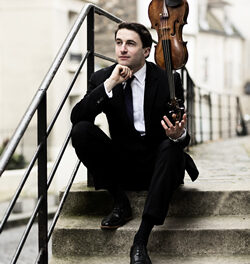Who knew that Albert Einstein was so smitten with the music of Mozart? Well, at least those in the overflow audience at Saint Mary’s School are now in on that little factoid. Those attendees in that school’s grand old Smedes Parlor on a warm fall evening were treated to the clever program, “Einstein: Speaking of Mozart.”
Hosting the program and providing apt commentary was pianist Barbara McKenzie, highly honored hereabouts and worldwide, an erstwhile student of Leon Fleisher and hence only “one generation” removed from everybody’s all-time great, Artur Schnabel. She pointed out that (violinist!) Einstein came up with the Theory of Relativity while playing and contemplating Mozart. (So might one suspect Mozart knew all along that “e” did indeed “equal mc squared,” but just never bothered to mention it?)
This pianist was prominent on both numbers in the first half. Three notable string players joined her, violinist Eric Pritchard, violist Kirsten Swanson and cellist Fred Raimi. These players successfully negotiated Mozart’s groundbreaking Piano Quartet in C Minor, K.478. Particularly pleasing in the Andante movement were the several duets. This “piano” quartet was well named, since the pianist’s light fingers did so much of the heavy lifting throughout. (When chided by members of the Juilliard String Quartet about his alleged lack of counting ability, Einstein is said to have retaliated with the masterly chiasmus: Not everything that counts can be counted, and not everything that can be counted counts.)
Of Mozart’s Piano Sonata No. 10, in C, K.330, a critic wrote long ago that it “…flows peacefully instead of being driven … intimate rather than orchestral….” The jolly Allegro was followed by the pianist’s sublime treatment of the Andante cantabile. The song-like melodies throughout lead one to suspect that Schubert must have been greatly influenced by this particular movement. (Einstein: Geniuses create because they must.)
Violinist Jacqui Carrasco and violist Scott Rawls joined the aforementioned string players in the huge Quintet for Strings, K.515. Were we listening to an especially full string quartet or a leaned-down string orchestra? In this “viola quintet” (employing two violas as opposed to the later Schubert’s use of two cellos), the players tossed off the colossal Allegro movement with poise. In a curious twist, the imposing Andante movement and the following Minuetto were of such similar character as to constitute a continuum. (Early releases were even said to have had the two movements reversed.) Here an ad hoc group of accomplished veteran string players came across as an ensemble of long time association. (Einstein: You can live as if nothing is a miracle. Or you can live as if everything is a miracle.)
The Smedes Parlor series resumes on November 5. See our calendar closer to the event for details.











